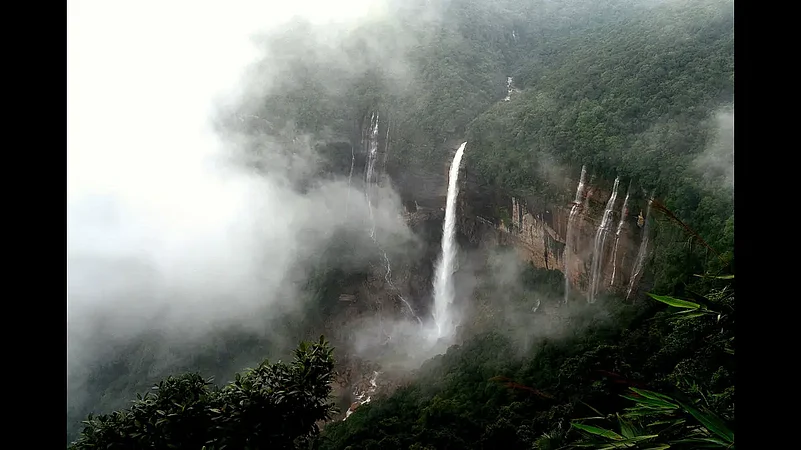Situated on a 1,484-m-high plateau on the southern edge of the Khasi Hills, Sohra – popularly known as Cherrapunjee – is a treasure-trove of natural wonders. The drive to this town takes visitors by surprise: the highway veers through rough-hewn hills and deep ravines, before opening out to undulating grasslands, with an occasional clump of shrubs. During the wet months, the road is shrouded with a thick mist that rises from the valley – a precursor to the region’s famed rains. Monsoons also mean the waterfalls are in their mightiest flourish – some of which even spill down the rock face onto roads. Although Sohra is the historical name, the British pronounced it as “Churra” due to their inability to grasp local phonetics and over the years, the name evolved to ‘Cherrapunjee’. If you find yourself in the area, here are the three waterfalls you must visit:
Dainthlen and Wei Sawdong Falls

On the way to Sohra, a road to the right leads to these spectacular 80–90-m-high falls, around 2km before the village begins. The waterfall derives its name from the legend of a thlen ( khasi word for snake). According to the myth, there was a thlen, an enormous demon python that used to live in a cave in this area. Tired of the snake’s evil ways, the locals decided to slaughter it. Adjacent to the spot where the thlen was killed, lie these falls. Spread across in the shape of a semicircle, this myth-laden waterfall is frequented by crowds of tourists. During the monsoon, the falls appear akin to a smaller version of the roaring Niagara Falls. Downstream of the Dainthlen Falls is one of Meghalaya’s prettiest cascades – the three-step Wei Sawdong Falls.
Noh Sngithiang Falls
Nohsngithiang Falls, locally known as Mawsmai Falls, this waterfall is located a kilometre south of the village of Mawsmai. The falls can be viewed from a deck located on the side of the road. This viewpoint overlooks a valley with the cluster of waterfalls – seven to be precise – plummeting from the cliff on the left. A limestone cliff segregates the falls into seven parts from where the Noh Sngithiang gets its name. The falls, with a drop of 315m, is one of the highest waterfalls in the country. During winter, the flow is depleted – we recommend you catch this sight during the post-monsoon months.
Nohkalikai Falls

A short and scenic drive away from Sohra lies the awe-inspiring Nohkalikai waterfall. The road curves through an elevated tableland, culminating at a cliff, from where the splendid Nohkalikai can be viewed. The viewing platform runs along the edge of a cliff. The 340-m-high Nohkalikai Falls is the highest plunge waterfall in India. During the monsoon, the water gushes down an escarpment with great intensity into a green rocky pool. Mist rises from the waters enveloping the picturesque surroundings, lending an ethereal quality to the environs. Depending on the season, the falls are at times accompanied by several minor waterfalls, leaping down into the gorge below. The chances of getting a clear view of the falls are, however, a matter of luck as clouds play spoilsport in these parts, often completely blanketing the falls. It can take anywhere from a few minutes to an hour for the clouds to lift. A few shops, eateries and tea stalls surround the parking lot and the viewing platform. bottles of the locally-made orange honey and cinnamon sticks that Sohra is famous for are available here.
















